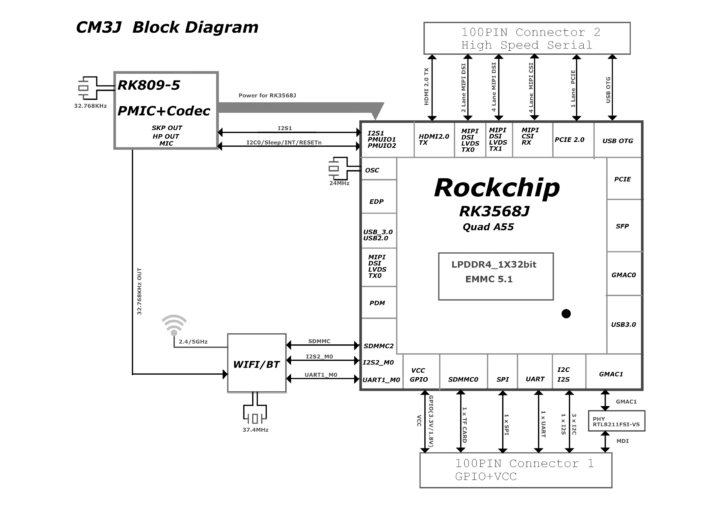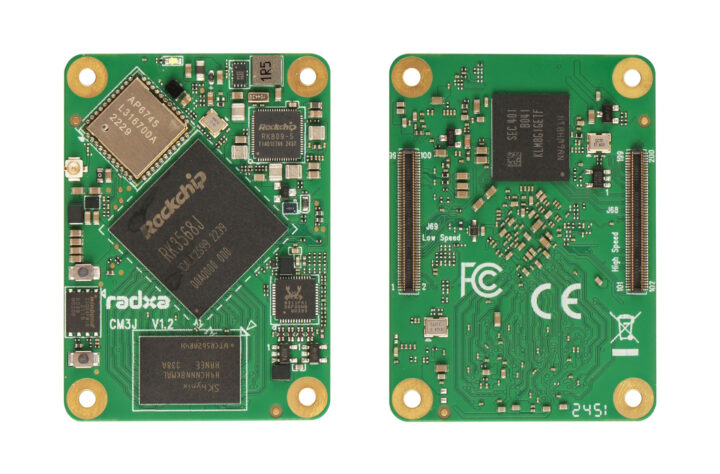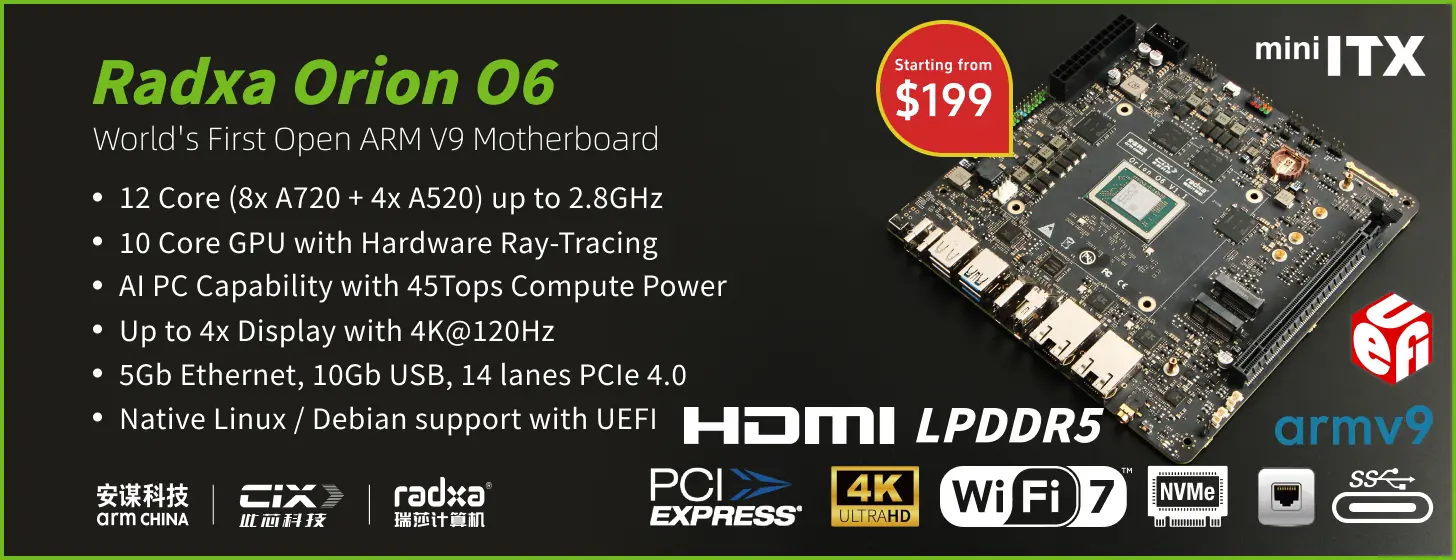Radxa CM3J is a Raspberry Pi Compute Module 4 compatible SoM powered by a Rockchip RK3568J industrial-grade quad-core Cortex-A55 SoC and equipped with up to 8GB LPDDR4x and up to 256GB eMMC flash.
It’s an update to the Radxa CM3 based on the Rockchip RK3566 SoC with an industrial temperature range and only two board-to-board connectors, and can also be viewed as a cost-down version of the Radxa CM3i with RK3568 and four B2B connectors. It competes directly against the industrial-grade Raspberry Pi Compute Module 4 introduced at the beginning of this month.
Radxa CM3J specifications compared to the Radxa CM3 and Raspberry Pi CM4:
Radxa CM3J | Radxa CM3 | Raspberry Pi CM4 |
|
|---|---|---|---|
| SoC | Rockchip RK3568J quad-core Cortex-A55 processor @ 2.0 GHz with Arm Mali-G52 2EE GPU, 1 TOPS AI accelerator | Rockchip RK3566 quad-core Cortex-A55 processor @ 2.0 GHz with Arm Mali-G52 2EE GPU, 0.8 TOPS AI accelerator | Broadcom BCM2711 quad-core Cortex-A72 processor @ 1.5 GHz with VideoCore VI GPU |
| System Memory | 2GB, 4GB or 8GB LPDDR4/LPDDR4x | 1GB, 2GB, 4GB or 8GB LPDDR4-3200 SDRAM |
|
| Storage | On-board eMMC Flash SPI flash for bootloader SDIO 3.0 | None, 8GB, 16GB, 32GB, 64GB, 128GB eMMC Flash memory up to 250MB/s SDIO 3.0 | None, 8GB, 16GB, 32GB, 64GB, 128GB eMMC Flash memory up to 100MB/s SDIO 2.0 for CM4Lite only |
| Display interfaces | 1x HDMI up to 4K60 1x 2-lane MIPI DSI display interfaces 1x 4-lane MIPI DSI display interfaces 1x 4-lane LVDS multiplexed with 1x MIPI DSI0 | 1x HDMI up to 4K60 2x 4-lane MIPI DSI display interfaces 1x 4-lane LVDS multiplexed with 1x MIPI DSI 1x eDP up to 4K60 | 2x HDMI up to 4K60 1x 2-lane MIPI DSI display interface 1x 4-lane MIPI DSI display interface |
| Camera interfaces | 2x 2-lane MIPI CSI or 1x 4-lane MIPI CSI camera | 1x 2-lane MIPI CSI 1x 4-lane MIPI CSI |
|
| Audio codec | Yes | No (must be on carrier board) |
|
| Ethernet | Gigabit Ethernet PHY | Gigabit Ethernet PHY with IEEE 1588 support |
|
| Wireless | Optional Wi-Fi 5 & Bluetooth 5.0 |
||
| USB | 1x USB 2.0 | 1x USB 2.0, 1x USB 3.0 (5 Gbps) | 1x USB 2.0 |
| PCIe | 1× 1-lane PCIe Gen 2 (5Gbps) |
||
| SATA | N/A | 2x SATA multiplexed with PCIe and USB 3.0 interfaces | N/A |
| GPIO | GPIO UART I2C CAN Bus I2S | 50x GPIO: Up to 8 × UART Up to 8 × I2C Up to 4 × SPI 1x SDIO interface 1x PCM Up to 8x PWM 2x ADC 1.8V and 3.3V support | 28x GPIO Up to 5x UART Up to 5x I2C Up to 5x SPI 1x SDIO interface 1x DPI (Parallel RGB Display) 1x PCM 2x PWM channels Up to 3x GPCLK outputs 1.8V and 3.3V support |
| Board-to-board connectors | 2x 100-pin B2B connectors | 3x 100-pin B2B connectors | 2x 100-pin B2B connectors |
| Supply Voltage | Single 5V input voltage |
||
| Dimensions | 55 x 40mm |
||
| Temperature Range | -40°C to 85°C | 0°C to 50°C | -20°C to 85°C or -40°C to 85°C |

 The Radxa CM3J has been tested with the official Raspberry Pi CM4 IO Board, WaveShare CM4POEUPSBASE, WaveShare CM4IOBASEB, and WaveShare CM4NANOB, but other carrier boards for the Compute Module 4 may also be supported. Like with other such modules, there’s no 100% pin compatibility with the Raspberry Pi CM4 as explained by Radxa:
The Radxa CM3J has been tested with the official Raspberry Pi CM4 IO Board, WaveShare CM4POEUPSBASE, WaveShare CM4IOBASEB, and WaveShare CM4NANOB, but other carrier boards for the Compute Module 4 may also be supported. Like with other such modules, there’s no 100% pin compatibility with the Raspberry Pi CM4 as explained by Radxa:
For compatibility of Radxa CM3 with Raspberry Pi CM4, most high speed buses just works such as USB, MIPI, PCIe etc. For the GPIO, since the pin mux is not identical, we can only be compatible with the primary alt function of Raspberry Pi CM4.
Radxa provides support for Debian, Ubuntu, and Android 11/12 operating systems. However, right now, I could only find bootloader images and a Debian image on the new documentation website, where you’ll also find PDF schematics, mechanical files, and a pinout diagram.
There are currently six variants of the CM3J, all with an AP6745 module, different RAM capacities (2GB, 4GB, or 8GB), and storage options (eMMC vs SPI flash). Radxa sells the CM3J with eMMC flash on AliExpress starting at $45.50 with the 2GB/8GB model, and on Arace starting at $50 for the 4GB/16GB variant. Additional information may also be found on the product page.

Jean-Luc started CNX Software in 2010 as a part-time endeavor, before quitting his job as a software engineering manager, and starting to write daily news, and reviews full time later in 2011.
Support CNX Software! Donate via cryptocurrencies, become a Patron on Patreon, or purchase goods on Amazon or Aliexpress






